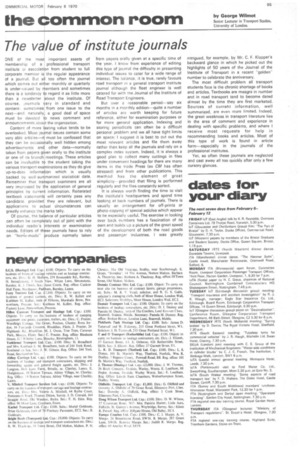The villue of institute journals
Page 97

If you've noticed an error in this article please click here to report it so we can fix it.
ONE of the mos important assets of membership of a professional transport institute or associati n from student to .full corporate member is the regular appearance of a journal. But all too often the journal which comes out either monthly or quarterly is under-valued by members and sometimes
there is a tendency regard it as little more than a newsletter bout the institute. Of course, journals ary in standard and contentsometimes from one issue to the next-and, naturally a good deal of space must be devoted o news comment and announcements abo t the organization.
Content of more I sting value tends to be overlooked. Most jo rnal issues contain some very able articles-i must be confessed that they can be occasio ally well hidden among advertisements and other data-normally taken from papers gi an orally to the institute or one of its branch meetings. These articles can be invaluable tq the student taking the various transport exa inations as they do give up-to-date information which is usually
backed by marized statistical data. Remember that traiIsport examiners are all very impressed by the application of general principles by curren information. Reiterated textbook statement will certainly pass any candidate, provided they are relevant, but applications to actual circumstances can greatly enhance the riarks tally.
Of course, the balance of particular articles can often be completely out of joint with the individual reader's nterests or examination needs. Editors of these journals have to rely on "horrie-made" produce normally taken from papers orally given at a specific time of the year. I know from experience of editing this type of journal the difficulty in presenting individual issues to cater for a wide range of interest. The balance, it is true, rarely favours road transport in a general transport institute journal although the fleet engineer is well catered for with the Journal of the Institute of Road Transport Engineers.
But over a reasonable period-say six months in a monthly edition-quite a number of articles are worth keeping for future reference, either for examination purposes or for more general application. Indexing and storing periodicals can often be a difficult personal problem and we all have tight limits on space; I suggest it is best to cut out the most relevant articles and file them away rather than keep all the journals and rely on a complex index system. Indeed, it is always a good plan to collect many cuttings in files under convenient headings for there are many items in the trade Press (as CM has often stressed) and from other publications. This method has the element of great simplicity-provided that filing is performed regularly and the files constantly sorted.
It is always worth finding the time to visit the institute's headquarters and spend time looking at back numbers of journals. There is usually an arrangement for off-prints or photo-copying of special asticles which appear to be especially useful. The exercise in looking over back numbers has a fascination of its own and builds up a picture of the great speed of the development of both the road goods and passenger industries. I was greatly intrigued, for example, by Mr. C. F. Klapper's backward glance in which he picked out the highlights of 50 years of the Journal of the Institute of Transport in a recent "golden" number to celebrate the anniversary.
The most difficult problem all transport students face is the chronic shortage of books and articles. Textbooks are meagre in number and in road transport tend to become dated almost by the. time they are first marketed. Sources of current information, well summarized, are even more limited. Indeed, the great weakness in transport literature lies in the area of comment and experience in dealing with specific problems, and where I receive most requests for help in recommending books and articles. Most of this type of work is found in article form-especially in the journals of the professional institutes.
Yet, so often these journals are neglected and cast away all too quickly after only a few cursory glances.


















































































































































